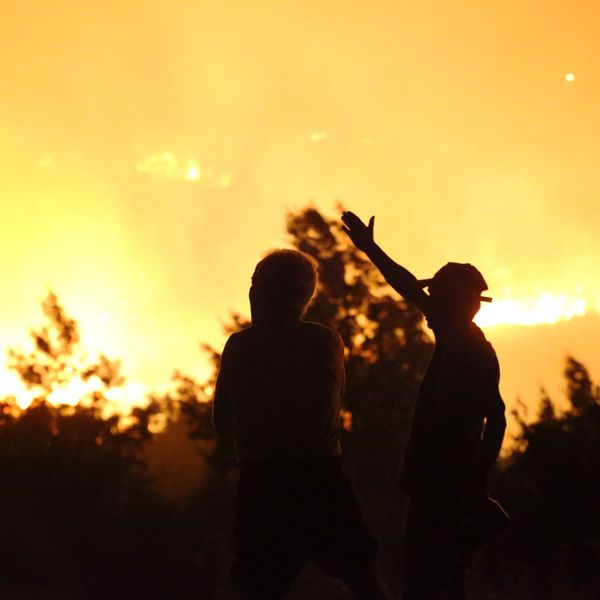
Demonstrators attend a protest demanding climate action on November 18, 2020. (Photo: Getty Images)
2021-2030: The Renewal Decade
Protecting and regenerating the viability of our blue-green home is the essential work of the next few years. Everyone is needed and we each have a role to play.
On June 5, World Environment Day, the United Nations is launching the UN Decade of Ecosystem Restoration--"a rallying call for the protection and revival of ecosystems all around the world, for the benefit of people and nature." The UN campaign asks us to reimagine, recreate and restore. Applying the prefix "re" to words and concepts imbues them with new energy, rousing us to reevaluate many of the global problems we face. This is our decade for renewal.
For starters, we need to rethink some dominant narratives, including the current, largely unspoken idea of civilization's "inevitable doom." Granted, scaring people may motivate some into action, but it can also result in unproductive despair or paralyzing climate anxiety. And it robs us, particularly the young, of our agency and hope.
How about we retire the "we're toast" narrative. Let's instead put the emphasis on all that is still within our power to protect (including intact functioning landscapes like old growth forests) and regenerate (degraded agricultural landscapes). Climate science tells us we have the solutions we need at hand, and, if we act with the urgency demanded of us, we have time to change the story's ending.
The answer, available to us immediately, is to work with nature. Her immense capacity for regeneration is the strongest force at our disposal to heal the Earth. As humans, we have the ability to create the conditions that will unleash these vast healing powers.
Examples of successful regeneration projects exist the world over:
Using adaptive grazing principles as a management tool, Alejandro Carrillo and his family have brought back grasslands on 25,000 acres (10,117 hectares) in Mexico's Chihuahuan Desert, a region that gets just eight inches of rain a year. Their Las Damas Ranch, once over grazed, is now a lush haven for grassland bird species. A broader regenerative effort in the region, covering more than a million acres of ranchland, is underway.
Pioneering a method of aggressive pruning known as "chop and drop," Brazil's Ernst Gotsch created the conditions for 1,200 acres (500 hectares) of clear-cut land to once again harbor streams and waterfalls. Biomass left to accumulate created a layer of protection for the soil that reestablished life below ground and supported prodigious above-ground growth. Today Gotsch's legendary farm is one of the most biodiverse remnants of the Atlantic Rainforest.
In Saudi Arabia, American Neal Spackman worked with a Bedouin community to green the desert by building simple check-dams, capturing precious rainwater that had previously washed away. When funding for the Al Bayda Project ran out in 2016 and work ceased, the saplings that had been planted tapped into the groundwater that had infiltrated along the rock dams and continued to grow without further human intervention.
In England's Lake District, James Rebanks, a shepherd whose family has been on the land for six centuries, created a diversified farm and welcomed back the region's iconic curlew, a bird species that has been in serious decline. Rebank's lauded 2020 book, English Pastoral, outlines his family's multi-generation journey from traditional to industrialized agriculture and, ultimately, to nature-friendly farming.
At Soul Fire Farm, in upstate New York, sisters Leah and Naima Penniman and their team are using Afro-indigenous practices including agroforestry and silvopasture to regenerate 80 acres (32 hectares) of land that was historically stewarded by the Mohican Nation. These ancient farming practices simultaneously increase topsoil depth, sequester soil carbon, and increase biodiversity.
Beyond these pioneering farmers and ranchers, a global network of Ecosystem Restoration Camps is emerging. The camp network, run by volunteers, is the brainchild of documentary filmmaker John D. Liu. When I first met Liu in 2016, the Ecocamps were working to launch their first site, Camp Altiplano, in arid southern Spain. Today there are 38 Ecocamps around the world powered by citizens contributing their skills and labor to regenerate degraded lands and damaged ecosystems.
As my friend Precious Phiri, a community organizer in her native Zimbabwe, points out, "With the right management tools, there is a possibility to reverse vicious cycles of desertification and poverty; Nature is forgiving."
The UN's Decade of Ecosystem Restoration gives crucial shape and stature to ecosystem restoration efforts that are underway in pockets around the globe. (Judith D. Schwartz has written about many of them in her uplifting 2020 book, The Reindeer Chronicles: And Other Inspiring Stories of Working with Nature to Heal the Earth.) Protecting and regenerating the viability of our blue-green home is the essential work of the next few years. Everyone is needed and we each have a role to play. Each one of us has something to contribute: skills, money, labor, time. Ecosystem restoration is a team sport. Above all, let's make sure the globe's most powerful force--nature--is playing for our side.
An Urgent Message From Our Co-Founder
Dear Common Dreams reader, The U.S. is on a fast track to authoritarianism like nothing I've ever seen. Meanwhile, corporate news outlets are utterly capitulating to Trump, twisting their coverage to avoid drawing his ire while lining up to stuff cash in his pockets. That's why I believe that Common Dreams is doing the best and most consequential reporting that we've ever done. Our small but mighty team is a progressive reporting powerhouse, covering the news every day that the corporate media never will. Our mission has always been simple: To inform. To inspire. And to ignite change for the common good. Now here's the key piece that I want all our readers to understand: None of this would be possible without your financial support. That's not just some fundraising cliche. It's the absolute and literal truth. We don't accept corporate advertising and never will. We don't have a paywall because we don't think people should be blocked from critical news based on their ability to pay. Everything we do is funded by the donations of readers like you. Will you donate now to help power the nonprofit, independent reporting of Common Dreams? Thank you for being a vital member of our community. Together, we can keep independent journalism alive when it’s needed most. - Craig Brown, Co-founder |
On June 5, World Environment Day, the United Nations is launching the UN Decade of Ecosystem Restoration--"a rallying call for the protection and revival of ecosystems all around the world, for the benefit of people and nature." The UN campaign asks us to reimagine, recreate and restore. Applying the prefix "re" to words and concepts imbues them with new energy, rousing us to reevaluate many of the global problems we face. This is our decade for renewal.
For starters, we need to rethink some dominant narratives, including the current, largely unspoken idea of civilization's "inevitable doom." Granted, scaring people may motivate some into action, but it can also result in unproductive despair or paralyzing climate anxiety. And it robs us, particularly the young, of our agency and hope.
How about we retire the "we're toast" narrative. Let's instead put the emphasis on all that is still within our power to protect (including intact functioning landscapes like old growth forests) and regenerate (degraded agricultural landscapes). Climate science tells us we have the solutions we need at hand, and, if we act with the urgency demanded of us, we have time to change the story's ending.
The answer, available to us immediately, is to work with nature. Her immense capacity for regeneration is the strongest force at our disposal to heal the Earth. As humans, we have the ability to create the conditions that will unleash these vast healing powers.
Examples of successful regeneration projects exist the world over:
Using adaptive grazing principles as a management tool, Alejandro Carrillo and his family have brought back grasslands on 25,000 acres (10,117 hectares) in Mexico's Chihuahuan Desert, a region that gets just eight inches of rain a year. Their Las Damas Ranch, once over grazed, is now a lush haven for grassland bird species. A broader regenerative effort in the region, covering more than a million acres of ranchland, is underway.
Pioneering a method of aggressive pruning known as "chop and drop," Brazil's Ernst Gotsch created the conditions for 1,200 acres (500 hectares) of clear-cut land to once again harbor streams and waterfalls. Biomass left to accumulate created a layer of protection for the soil that reestablished life below ground and supported prodigious above-ground growth. Today Gotsch's legendary farm is one of the most biodiverse remnants of the Atlantic Rainforest.
In Saudi Arabia, American Neal Spackman worked with a Bedouin community to green the desert by building simple check-dams, capturing precious rainwater that had previously washed away. When funding for the Al Bayda Project ran out in 2016 and work ceased, the saplings that had been planted tapped into the groundwater that had infiltrated along the rock dams and continued to grow without further human intervention.
In England's Lake District, James Rebanks, a shepherd whose family has been on the land for six centuries, created a diversified farm and welcomed back the region's iconic curlew, a bird species that has been in serious decline. Rebank's lauded 2020 book, English Pastoral, outlines his family's multi-generation journey from traditional to industrialized agriculture and, ultimately, to nature-friendly farming.
At Soul Fire Farm, in upstate New York, sisters Leah and Naima Penniman and their team are using Afro-indigenous practices including agroforestry and silvopasture to regenerate 80 acres (32 hectares) of land that was historically stewarded by the Mohican Nation. These ancient farming practices simultaneously increase topsoil depth, sequester soil carbon, and increase biodiversity.
Beyond these pioneering farmers and ranchers, a global network of Ecosystem Restoration Camps is emerging. The camp network, run by volunteers, is the brainchild of documentary filmmaker John D. Liu. When I first met Liu in 2016, the Ecocamps were working to launch their first site, Camp Altiplano, in arid southern Spain. Today there are 38 Ecocamps around the world powered by citizens contributing their skills and labor to regenerate degraded lands and damaged ecosystems.
As my friend Precious Phiri, a community organizer in her native Zimbabwe, points out, "With the right management tools, there is a possibility to reverse vicious cycles of desertification and poverty; Nature is forgiving."
The UN's Decade of Ecosystem Restoration gives crucial shape and stature to ecosystem restoration efforts that are underway in pockets around the globe. (Judith D. Schwartz has written about many of them in her uplifting 2020 book, The Reindeer Chronicles: And Other Inspiring Stories of Working with Nature to Heal the Earth.) Protecting and regenerating the viability of our blue-green home is the essential work of the next few years. Everyone is needed and we each have a role to play. Each one of us has something to contribute: skills, money, labor, time. Ecosystem restoration is a team sport. Above all, let's make sure the globe's most powerful force--nature--is playing for our side.
On June 5, World Environment Day, the United Nations is launching the UN Decade of Ecosystem Restoration--"a rallying call for the protection and revival of ecosystems all around the world, for the benefit of people and nature." The UN campaign asks us to reimagine, recreate and restore. Applying the prefix "re" to words and concepts imbues them with new energy, rousing us to reevaluate many of the global problems we face. This is our decade for renewal.
For starters, we need to rethink some dominant narratives, including the current, largely unspoken idea of civilization's "inevitable doom." Granted, scaring people may motivate some into action, but it can also result in unproductive despair or paralyzing climate anxiety. And it robs us, particularly the young, of our agency and hope.
How about we retire the "we're toast" narrative. Let's instead put the emphasis on all that is still within our power to protect (including intact functioning landscapes like old growth forests) and regenerate (degraded agricultural landscapes). Climate science tells us we have the solutions we need at hand, and, if we act with the urgency demanded of us, we have time to change the story's ending.
The answer, available to us immediately, is to work with nature. Her immense capacity for regeneration is the strongest force at our disposal to heal the Earth. As humans, we have the ability to create the conditions that will unleash these vast healing powers.
Examples of successful regeneration projects exist the world over:
Using adaptive grazing principles as a management tool, Alejandro Carrillo and his family have brought back grasslands on 25,000 acres (10,117 hectares) in Mexico's Chihuahuan Desert, a region that gets just eight inches of rain a year. Their Las Damas Ranch, once over grazed, is now a lush haven for grassland bird species. A broader regenerative effort in the region, covering more than a million acres of ranchland, is underway.
Pioneering a method of aggressive pruning known as "chop and drop," Brazil's Ernst Gotsch created the conditions for 1,200 acres (500 hectares) of clear-cut land to once again harbor streams and waterfalls. Biomass left to accumulate created a layer of protection for the soil that reestablished life below ground and supported prodigious above-ground growth. Today Gotsch's legendary farm is one of the most biodiverse remnants of the Atlantic Rainforest.
In Saudi Arabia, American Neal Spackman worked with a Bedouin community to green the desert by building simple check-dams, capturing precious rainwater that had previously washed away. When funding for the Al Bayda Project ran out in 2016 and work ceased, the saplings that had been planted tapped into the groundwater that had infiltrated along the rock dams and continued to grow without further human intervention.
In England's Lake District, James Rebanks, a shepherd whose family has been on the land for six centuries, created a diversified farm and welcomed back the region's iconic curlew, a bird species that has been in serious decline. Rebank's lauded 2020 book, English Pastoral, outlines his family's multi-generation journey from traditional to industrialized agriculture and, ultimately, to nature-friendly farming.
At Soul Fire Farm, in upstate New York, sisters Leah and Naima Penniman and their team are using Afro-indigenous practices including agroforestry and silvopasture to regenerate 80 acres (32 hectares) of land that was historically stewarded by the Mohican Nation. These ancient farming practices simultaneously increase topsoil depth, sequester soil carbon, and increase biodiversity.
Beyond these pioneering farmers and ranchers, a global network of Ecosystem Restoration Camps is emerging. The camp network, run by volunteers, is the brainchild of documentary filmmaker John D. Liu. When I first met Liu in 2016, the Ecocamps were working to launch their first site, Camp Altiplano, in arid southern Spain. Today there are 38 Ecocamps around the world powered by citizens contributing their skills and labor to regenerate degraded lands and damaged ecosystems.
As my friend Precious Phiri, a community organizer in her native Zimbabwe, points out, "With the right management tools, there is a possibility to reverse vicious cycles of desertification and poverty; Nature is forgiving."
The UN's Decade of Ecosystem Restoration gives crucial shape and stature to ecosystem restoration efforts that are underway in pockets around the globe. (Judith D. Schwartz has written about many of them in her uplifting 2020 book, The Reindeer Chronicles: And Other Inspiring Stories of Working with Nature to Heal the Earth.) Protecting and regenerating the viability of our blue-green home is the essential work of the next few years. Everyone is needed and we each have a role to play. Each one of us has something to contribute: skills, money, labor, time. Ecosystem restoration is a team sport. Above all, let's make sure the globe's most powerful force--nature--is playing for our side.

